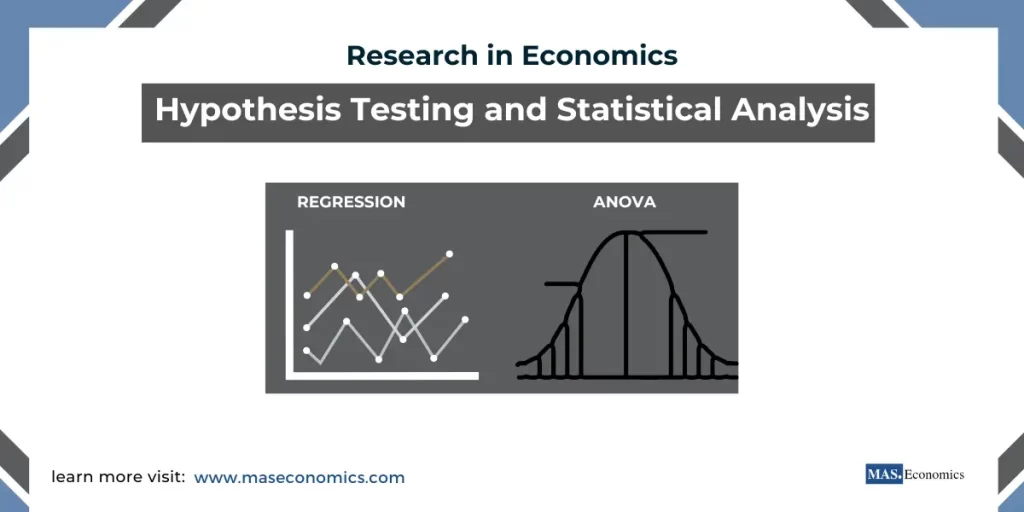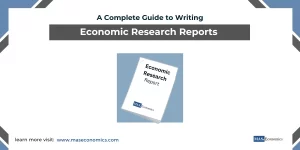In economics, hypothesis testing is a crucial component of empirical research. It allows economists to assess whether their theoretical assumptions about economic relationships hold when tested against real-world data. From understanding the effects of policy changes to evaluating market behaviors, hypothesis testing provides a structured way to test predictions and draw meaningful conclusions about economic phenomena.
Hypothesis testing in economics relies on various statistical techniques, such as t-tests, chi-squared tests, and regression analysis, which enable researchers to determine whether observed data supports or refutes a hypothesis. Understanding the importance of p-values, confidence intervals, and statistical significance is essential for interpreting these tests and verifying hypotheses.
In this article, we will explore the key statistical tests used in hypothesis testing, explain the role of p-values and confidence intervals, and provide practical examples from economic studies to illustrate how hypothesis testing is applied in real-world research.
Key Statistical Tests Used in Hypothesis Testing in Economics
Hypothesis testing involves several types of statistical tests, each designed to assess different kinds of data and relationships between variables. Let’s explore some of the most common statistical tests used in economics:
T-Tests
A t-test is used to determine whether there is a statistically significant difference between the means of the two groups. In economics, t-tests are often used to compare sample means to test hypotheses about population parameters.
Example: Testing Wage Differences Between Sectors
An economist might use a t-test to determine whether there is a significant difference in average wages between two sectors, such as manufacturing and technology. The null hypothesis (H₀) would state that the mean wage in both sectors is the same, while the alternative hypothesis (H₁) would suggest a difference. If the t-test results indicate that the mean wage in the technology sector is significantly higher than in manufacturing, the null hypothesis would be rejected.
When to Use a T-Test:
- When comparing the means of the two groups.
- When the data is continuous and follows a normal distribution.
- When sample sizes are relatively small.
Chi-Squared Tests
A chi-squared test is used to assess whether there is a significant association between categorical variables. This test is commonly applied in economics to examine relationships between factors like demographic groups and economic behaviors.
Example: Testing the Relationship Between Education Level and Employment Status
An economist might use a chi-squared test to explore whether education level is related to employment status. The null hypothesis would state that education and employment status are independent, while the alternative hypothesis suggests a relationship between the two. If the chi-squared test shows a significant association, the null hypothesis is rejected, indicating that education levels do influence employment outcomes.
When to Use a Chi-Squared Test:
- When analyzing relationships between categorical variables.
- When data is presented in the form of frequency counts.
- When testing for independence between variables.
ANOVA (Analysis of Variance)
ANOVA is used to compare the means of three or more groups to determine whether at least one of the group means differs from the others. In economics, ANOVA is useful for comparing multiple categories or regions.
Example: Comparing GDP Growth Across Regions
An economist studying regional economic growth might use ANOVA to compare GDP growth rates across multiple regions within a country. The null hypothesis would state that the mean GDP growth rate is the same across all regions, while the alternative hypothesis suggests that at least one region has a significantly different growth rate.
When to Use ANOVA:
- When comparing the means of three or more groups.
- When testing differences between groups means to identify variance.
Regression Analysis
Regression analysis is one of the most widely used statistical techniques in economics. It helps measure the strength and direction of the relationship between a dependent variable and one or more independent variables. Simple linear regression involves one independent and one dependent variable, while multiple regression includes more than one independent variable.
Example: Testing the Relationship Between Interest Rates and Inflation
An economist might use regression analysis to test whether changes in interest rates (independent variable) influence inflation (dependent variable). The regression equation could take the form:
Inflation = α + β(Interest Rate) + ε, where α is the intercept, β is the coefficient representing the effect of interest rates on inflation, and ε is the error term. If the coefficient β is statistically significant, it suggests a meaningful relationship between interest rates and inflation.
When to Use Regression Analysis:
- When examining the relationship between two or more variables.
- When testing the effects of independent variables on a dependent variable.
- When predicting outcomes based on the relationships between variables.
Understanding P-Values, Confidence Intervals, and Statistical Significance
To verify hypotheses in economics, it’s essential to understand the role of p-values, confidence intervals, and statistical significance in hypothesis testing.
P-Values
The p-value represents the probability that the observed data would occur under the assumption that the null hypothesis is true. In most economic studies, a p-value below a certain threshold (commonly 0.05) indicates that the null hypothesis can be rejected, meaning the observed effect is statistically significant.
Example: P-Value in Testing the Effect of Interest Rates on Inflation
If an economist performs a regression analysis to test whether interest rates affect inflation and obtains a p-value of 0.02, this suggests that there is only a 2% chance that the observed relationship between interest rates and inflation is due to random chance. Therefore, the economist would reject the null hypothesis, concluding that interest rates do indeed influence inflation.
Key Points About P-Values:
- A lower p-value (<0.05) indicates stronger evidence against the null hypothesis.
- A p-value does not measure the size or importance of an effect, only the probability that the result is due to chance.
Confidence Intervals
A confidence interval provides a range of values within which the true value of the parameter is expected to fall, with a given level of confidence (usually 95%). Confidence intervals help economists assess the precision of their estimates.
Example: Confidence Interval for the Effect of Interest Rates on Inflation
In the same regression analysis, if the 95% confidence interval for the coefficient of interest rates is [0.1, 0.5], it means the economist is 95% confident that the true effect of interest rates on inflation falls within this range. If the interval does not include 0, it suggests that the relationship is statistically significant.
Key Points About Confidence Intervals:
- A narrower confidence interval indicates a more precise estimate.
- Confidence intervals help provide context for the magnitude of the effect.
Statistical Significance
Statistical significance refers to the likelihood that a result is not due to random variation. If the p-value is below the chosen significance level (e.g., 0.05), the result is considered statistically significant. However, statistical significance does not necessarily imply practical significance, meaning the size of the effect should also be considered.
Example: Statistical Significance in Minimum Wage Studies
In a study on the effects of minimum wage increases on employment, an economist might find a statistically significant relationship between higher minimum wages and reduced employment. However, if the effect size is very small (e.g., a 0.5% reduction in employment), the result may not have practical significance, even though it is statistically significant.
Key Points About Statistical Significance:
- A statistically significant result suggests that the observed effect is unlikely to be due to chance.
- Statistical significance should be considered alongside the effect size to determine the practical relevance of the result.
Practical Examples of Hypothesis Testing in Economics
Testing the Impact of Education on Earnings
An economist might hypothesize that higher levels of education lead to higher earnings. Using regression analysis, the economist could test the hypothesis by analyzing data on education levels and income. If the coefficient for education is statistically significant with a p-value below 0.05, the economist would reject the null hypothesis and conclude that education positively impacts earnings.
Analyzing the Effect of Trade Tariffs on Imports
In a study of the effects of trade tariffs on import levels, an economist could use a t-test to compare import volumes before and after the imposition of tariffs. If the t-test shows a statistically significant difference in import volumes, the economist could conclude that the tariffs have had an impact on trade flows.
Testing the Phillips Curve Hypothesis
The Phillips Curve suggests an inverse relationship between inflation and unemployment. To test this hypothesis, an economist could use regression analysis to examine historical data on inflation and unemployment rates. If the regression results show a statistically significant negative coefficient for inflation, the economist would reject the null hypothesis and confirm the Phillips Curve relationship.
Conclusion
Hypothesis testing in economics is essential for validating theories, testing predictions, and making data-driven decisions. By applying statistical tests like t-tests, chi-squared tests, and regression analysis, economists can assess whether their hypotheses are supported by empirical data. Understanding the importance of p-values, confidence intervals, and statistical significance ensures that results are interpreted accurately and meaningfully.
FAQs:
What is hypothesis testing in economics?
Hypothesis testing in economics is a statistical method used to assess whether theoretical assumptions about economic relationships hold true when tested against real-world data. It allows economists to evaluate the validity of hypotheses by analyzing the evidence from empirical data.
Why is hypothesis testing important in economic research?
Hypothesis testing is important because it provides a structured way for economists to test predictions, validate theories, and make data-driven conclusions. It helps determine whether the observed relationships between variables are statistically significant and not due to chance.
What is a t-test used for in economics?
A t-test is used to determine whether there is a significant difference between the means of two groups. In economics, it can be applied to compare variables such as wages between different sectors or GDP growth across regions.
When is a chi-squared test used in economics?
A chi-squared test is used to analyze relationships between categorical variables, such as whether education level is related to employment status. It helps determine whether there is a significant association between the variables.
What is ANOVA, and when is it used in economic research?
ANOVA (Analysis of Variance) is used to compare the means of three or more groups to determine whether at least one group differs significantly from the others. It is often used in economics to compare data across regions, industries, or time periods.
What is regression analysis, and why is it commonly used in economics?
Regression analysis is a statistical method used to measure the relationship between a dependent variable and one or more independent variables. It is widely used in economics to examine how factors like interest rates, education, or policies affect economic outcomes.
What is a p-value, and why is it important in hypothesis testing?
A p-value represents the probability that the observed data would occur if the null hypothesis were true. In economics, a p-value below 0.05 is often considered statistically significant, indicating that the observed effect is unlikely to be due to chance.
What is a confidence interval, and what does it tell economists?
A confidence interval provides a range of values within which the true parameter is likely to fall, with a certain level of confidence (usually 95%). It helps economists assess the precision of their estimates and gives context to the magnitude of the effect.
What does statistical significance mean in economic studies?
Statistical significance means that the observed result is unlikely to be due to random chance. However, statistical significance does not imply practical significance, meaning that the size of the effect should also be considered when interpreting results.
Can you provide an example of hypothesis testing in economics?
An example of hypothesis testing in economics would be analyzing whether higher education levels lead to higher earnings. An economist could use regression analysis to test this hypothesis by analyzing data on education and income. If the p-value for the education variable is below 0.05, the economist would reject the null hypothesis, concluding that education has a statistically significant impact on earnings.
Thanks for reading! Share this with friends and spread the knowledge if you found it helpful.
Happy learning with MASEconomics




